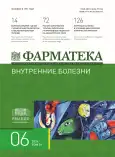Dynamics of quality of life indicators and exercise tolerance during outpatient cardiac rehabilitation of patients after coronary revascularization (original article)
- 作者: Ivanchukova M.G.1
-
隶属关系:
- Penza Institute for Advanced Medical Training – Branch Campus of the Russian Medical Academy of Postgraduate Education
- 期: 卷 31, 编号 6 (2024)
- 页面: 66-70
- 栏目: Cardiology
- URL: https://journal-vniispk.ru/2073-4034/article/view/273314
- DOI: https://doi.org/10.18565/pharmateca.2024.6.66-70
- ID: 273314
如何引用文章
详细
Background. The importance of cardiac rehabilitation (CR) is difficult to overestimate. Over the past decades, evidence of the positive impact of CR on the clinical condition and prognosis, the formation of greater adherence to drug treatment, and an improvement in the psychological state of patients after percutaneous coronary interventions (PCI) and coronary artery bypass grafting has accumulated.
Objective. Evaluation of the dynamics of quality of life indicators and exercise tolerance in patients after PCI or coronary artery bypass grafting (CABG) at the outpatient stage of CR using a hybrid CR model.
Methods. The study included 85 patients (66 men and 19 women) 1 month after primary coronary revascularization, who underwent the first and/or second stages of CR and were at the outpatient stage. The patients’ age ranged from 42 to 79 years, mean age – 60.8 ± 7.2 years. Two groups were identified: 1st – 35 (41.2%) patients who underwent PCI with stenting; 2nd – 50 (58.8%) patients after CABG. All patients participated in CR programs in a hybrid format, which included a visit to the clinic in combination with aerobic and combined training at home. Three times (1, 6 and 12 months after surgery) a face-to-face survey using the SF-36 quality of life questionnaire was conducted; an assessment of exercise tolerance using the six-minute walk test (SMWT) was performed twice (1 and 12 months after coronary revascularization).
Results. An improvement in the quality of life of patients after PCI and CABG was shown 6 and 12 months after the intervention, while the type of surgical treatment did not matter, more significant changes occurred during the first half of the CR.
Conclusions. Participation in CR programs contributes to an improvement in quality of life, an increase in exercise tolerance, regardless of the method of coronary revascularization. The use of alternative CR models has shown sufficient effectiveness in relation to the psychological characteristics of the patient’s health, and the physical functional capabilities of the body.
作者简介
M. Ivanchukova
Penza Institute for Advanced Medical Training – Branch Campus of the Russian Medical Academy of Postgraduate Education
编辑信件的主要联系方式.
Email: ivanchukovamg@yandex.ru
ORCID iD: 0000-0002-9741-7333
Teaching Assistant
俄罗斯联邦, Penza参考
- Погосова Н.В. Значимость кардиореабилитации в эпоху современного лечения сердечно-сосудистых заболеваний. Кардиология. 2022;62(4):3–11. [Pogosova N.V. The Importance of Cardiorehabilitation in the era of modern treatment of cardiovascular diseases. Kardiologiia. 2022;62(4):3–11. (In Russ.)]. doi: 10.18087/cardio.2022.4.n2015.
- Helton Oliveira Campos, Quйzia Teixeira Rodrigues, Lucas Rios Drummond et al. Exercise-based cardiac rehabilitation after myocardial revascularization: a systematic review and meta-analysis. Rev Cardiovasc Med. 2022;23(2):74. doi: 10.31083/j.rcm2302074.
- Dibben G.O., Faulkner J., Oldridge N. et al. Exercise-based cardiac rehabilitation for coronary heart disease: a meta-analysis. Eur Heart J. 2023,44(6):452–69. doi: 10.1093/eurheartj/ehac747.
- Владимирский В.Е., Владимирский Е.В., Юдина Е.А. и др. Реабилитация больных ИБС после реваскуляризации миокарда: доказательная база, методология, возможности (обзор). Вестник восстановительной медицины. 2020;6(100):45–56. [Vladimirsky V.E., Vladimirsky E.V., Yudina E.A. et al. Rehabilitation of Patients with Coronary Heart Disease after Myocardial Revascularization: Evidence Base, Methodology, Opportunities. Vestnik vosstanovitel’noi meditsiny. 2020;6(100):45–56. (In Russ.)]. doi: 10.38025/2078-1962-2020-100-6-45-56.
- Krishnamurthi N., Schopfer D.W., Shen H., et al. Association of Home‐Based Cardiac Rehabilitation With Lower Mortality in Patients With Cardiovascular Disease: Results From the Veterans Health Administration Healthy Heart Program. JАHA. 2023;12(5):e025856. doi: 10.1161/JAHA.122.025856.
- Hartog J., Blokzijl F., Dijkstra S., et al. Heart rehabilitation in patients awaiting Open heart surgery targeting to prevent complications and to improve quality of life (Heart-ROCQ): study protocol for a prospective, randomised, open, blinded endpoint (PROBE) trial. BMJ Open. 2019;9(9):e031738. doi: 10.1136/bmjopen-2019-031738.
- Новик А.А. Ионова Т.И. Руководство по исследованию качества жизни в медицине. 2-е изд. под ред. Ю.Л. Шевченко, М., ОЛМАПРЕСС, 2007. 313 с. [Novik A.A., Ionova T.I. Guidelines for the study of quality of life in medicine. 2nd ed. edited by Y.L. Shevchenko. Moscow: OLMA-PRESS, 2007. 313 p. (In Russ.)].
- Иноземцева А.А. Применение нагрузочного тестирования пациентов после коронарного шунтирования для оценки эффективности операции, определения реабилитационных возможностей и прогноза. Бюллетень сибирской медицины. 2018;17(4):221–28. [Inozemtseva A.A. The use of stress test in patients after coronary artery bypass grafting to assess the effectiveness of surgery, determination of rehabilitation possibilities and prognosis. Byulleten’ sibirskoi meditsiny. 2018;17(4):221–28. (In Russ.)]. doi: 10.20538/1682-0363-2018-4221-228.
- Prabhu N.V., Maiya A.G., Prabhu N.S. Impact of Cardiac Rehabilitation on Functional Capacity and Physical Activity after Coronary Revascularization: A Scientific Review. Cardiol Res Pract. 2020:1236968. doi: 10.1155/2020/1236968.
- Dimagli A., Spadaccio C., Myers A., Demetres M., et al. Quality of Life After Percutaneous Coronary Intervention Versus Coronary Artery Bypass Grafting. JAHA. 2023;12(22):e030069. doi: 10.1161/JAHA.123.030069.
- Kulik A. Quality of life after coronary artery bypass graft surgery versus percutaneous coronary intervention: what do the trials tell us? Curr Opin Cardiol. 2017;32(6):707–14. doi: 10.1097/HCO.0000000000000458.
- Rahman A., Haider R., Shirin H., et al. Evaluate the quality of life in patients with percutaneous coronary intervention versus coronary artery bypass graft. Cureus. 2024;16(1):e52645. doi: 10.7759/cureus.52645.
补充文件








